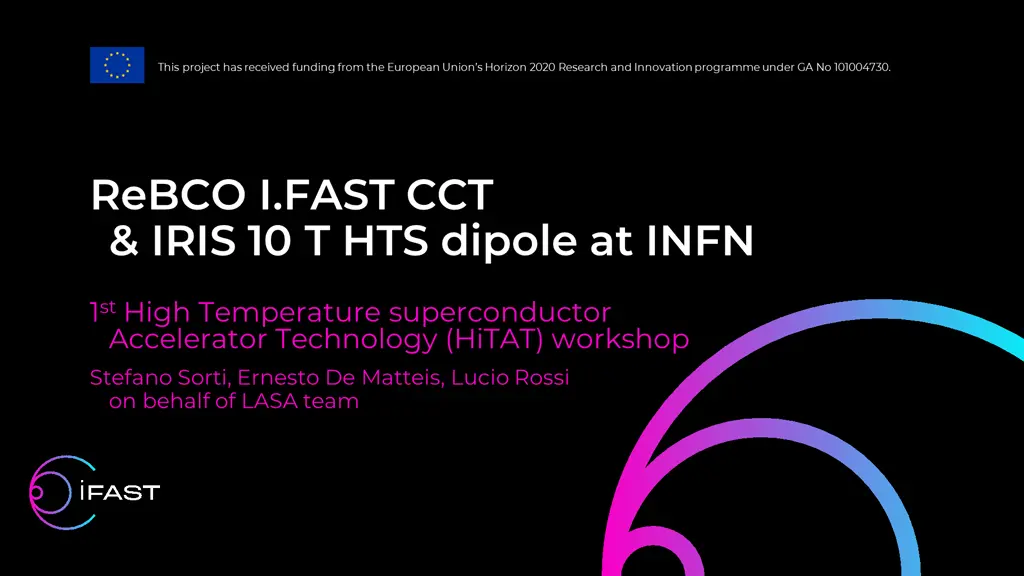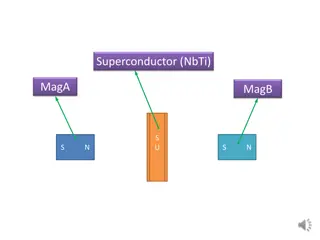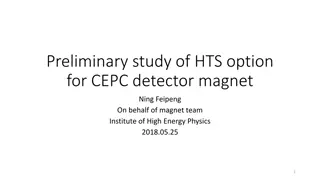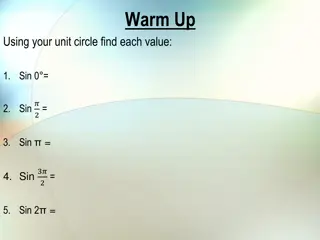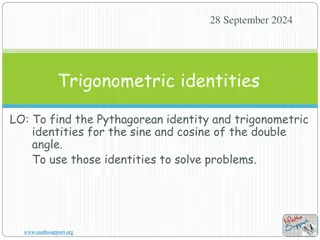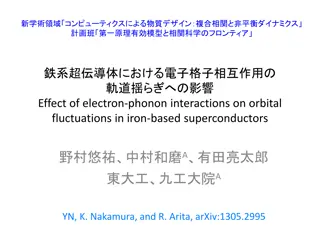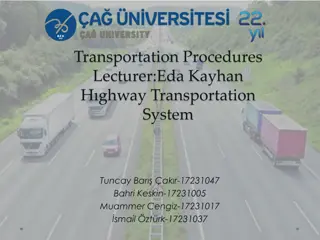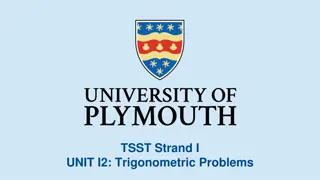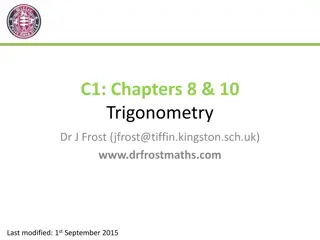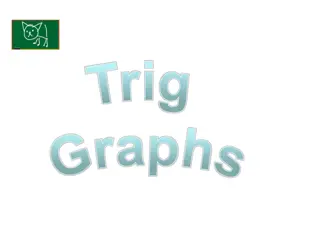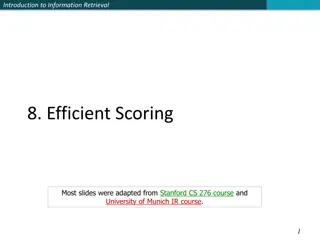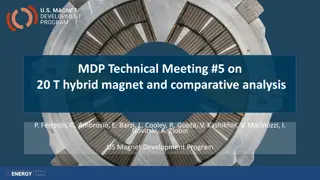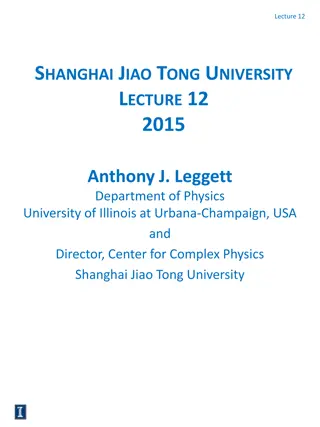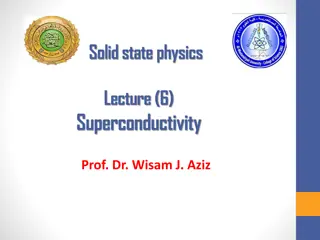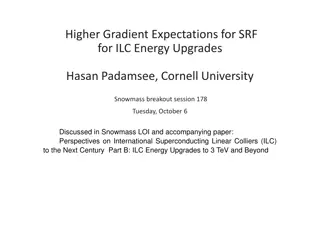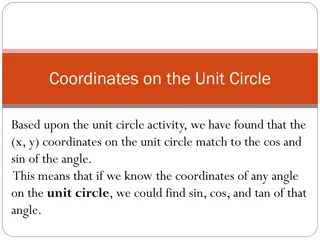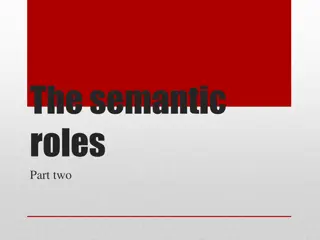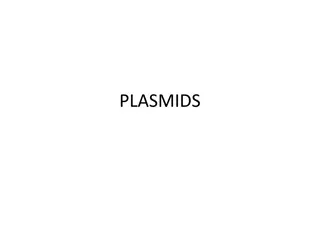Exploring Canted Cosine Theta with HTS Superconductors
This project delves into innovative superconducting magnets, particularly CCT in HTS, aiming to form strategic partnerships for HTS magnet technology in accelerators. Tasks include coordination, engineering designs, and construction of demonstrator magnets. The project also focuses on the conceptual design and further development of HTS magnets.
Download Presentation

Please find below an Image/Link to download the presentation.
The content on the website is provided AS IS for your information and personal use only. It may not be sold, licensed, or shared on other websites without obtaining consent from the author. Download presentation by click this link. If you encounter any issues during the download, it is possible that the publisher has removed the file from their server.
E N D
Presentation Transcript
This project has received funding from the European Unions Horizon 2020 Research and Innovation programme under GA No 101004730. ReBCO I.FAST CCT & IRIS 10 T HTS dipole at INFN 1stHigh Temperature superconductor Accelerator Technology (HiTAT) workshop Stefano Sorti, Ernesto De Matteis, Lucio Rossi on behalf of LASA team
Contents I.FAST WP8, Innovative superconducting magnets (explicitly, CCT in HTS) IRIS project, an Innovative Research Infrastructure on applied Superconductivity Stefano Sorti ReBCO I.FAST CCT & IRIS 10 T HTS dipole at INFN HiTAT workshop, 10/03/2023 2/12
IFAST WP8: main overview SCOPES: Exploring Canted Cosine Theta (CCT) with HTS superconductor (main goal), combined function CCT based on LTS, involving the industries that want to magnets Form a permanent European Strategy Group, open to worldwide partners, to discuss the European strategy for HTS magnets for accelerators, and to improve Industry involvement in this technology TASKS: 8.1 - Coordination and HTS Strategy Group proceeded by a 8.2 Preliminary Engineering design of comb. CCT magnet learn about the CCT 8.3 8.3 Preliminary Engineering design of HTS CCT Preliminary Engineering design of HTS CCT 8.4 - Construction of combined CCT magnet demonstrator 8.5 Construction of HTS CCT magnet demonstrator 8.6 Development of ReBCO HTS nuclotron cable 8.1 8.1 8.2 8.2 8.3 8.3 8.4 8.4 8.5 8.5 Stefano Sorti ReBCO I.FAST CCT & IRIS 10 T HTS dipole at INFN HiTAT workshop, 10/03/2023 3/12
IFAST WP8: M33 Conceptual Design of HTS Magnet Baseline is a 80-mm, 1-m-long, 4 T dipole at 10 K. Cooling with cryocoolers low current (< 2kA). Superconductor is ReBCO* tape, 2-tapes cable. 18 cables in groove, 1100 A per cable. Design candidates (preliminary), without iron: 1. Metal Insulation-like (MI); 2. Insulated-like (INS) with added copper. Protection aspect is the critical point for both: 1. No classical protection for the MI; 2. Vd<5 mV in 13 V, <60 ms detect for the INS, adding more than 260 m of copper. See HTS Cable for IFAST CCT (Thibault LECREVISSE, 09/03) 4-mm tape MI cable INS cable Stefano Sorti ReBCO I.FAST CCT & IRIS 10 T HTS dipole at INFN HiTAT workshop, 10/03/2023 4/12 *different vendors are compared in M33
IFAST WP8: Further Design of HTS Magnet, pt. I INS option with Cu stabilizer is pursued. New Topis 20 K, Two further design options: 1. 2-tapes cable (980 A) 2. 4-tapes cable (1990 A) Collaboration with Jeroen van Nugteren (Little Beast Engineering) M33 design suffers from high AC losses (~100 W, 25 cm2): Soldering all tapes inside the cable under consideration; Accelerator-level field-quality (integral below-unit), no iron yoke (shielding open problem); Ongoing mechanical studies, both manufacturing and strength. Minimum rib thickness is 1 mm (against 0.4 mm LTS), but Frenet-Serret employed (no radial grooves). Stefano Sorti ReBCO I.FAST CCT & IRIS 10 T HTS dipole at INFN HiTAT workshop, 10/03/2023 5/12
IFAST WP8: Further Design of HTS Magnet, pt. II Temperature margin of 10 K. Quench protection system is being demanded for better performances: 1. Inductive signal to be compensated; 2. Higher Vd, above AC losses voltage (which is ~50 mV); 3. Push the detection time to the lowest limit possible. 4. Varistor unit? AC losses currently being recomputed (specially for the 4-tapes option), baseline 2 cryocoolers (now at 20 K). WP8, D8.3 deliverable soon-to-be-written, including the results of the ongoing studies. Stefano Sorti ReBCO I.FAST CCT & IRIS 10 T HTS dipole at INFN HiTAT workshop, 10/03/2023 6/12
IRIS project A distributed research infrastructure A wide range of objectives 1. 2. Fundamental Physics instrumentation Societal Applications Green: energy transport at zero emission and energy saving magnets; Medical: Superconductivity could play a key role in heavy ion therapy by enabling a rotatable gantry; Two full-scale demonstrators. Final deadline is 30 October 2025. 3. 4. Stefano Sorti ReBCO I.FAST CCT & IRIS 10 T HTS dipole at INFN HiTAT workshop, 10/03/2023 7/12
Demonstrators proposal Green Superconducting Line Energy Saving HTS magnet Energy transport at 03emission: Main goal: 10 T 20 K, 10 K margin, conduction cooled. Aperture 150 mm X 50 mm, with 700 mm straight section, for cable test (at INFN- Genova). Additionally, technology driver for 15 T 20 K magnets for FCC or Muon-C. Around 10 km of 12 mm wide ReBCO tape. Stack cable with controlled-insulation. Charging time in the range of (a few) hours. 1. Zero (almost) emission of C02 : consumption will be 1% over 1000 km 2. Zero emission of e.m. radiation (DC) Zero (almost) land consumption: a 50 cm underground pipe can carry the 5 GW power of 30 m X 50 m overhead line. 25 kV - 40kA, at 20 K (50+ kV testing) Round MgB2strands, cooled with He gas; after IRIS, investigation on LH cooling. 3. Stefano Sorti ReBCO I.FAST CCT & IRIS 10 T HTS dipole at INFN HiTAT workshop, 10/03/2023 8/12
HTS magnet (and green line) kick-off adaptation Revising concept (a) to a simpler design, focus is to test technologies (cryocoolers, C.I.), racetrack coils as baseline for design (b) Project approval under budget review, HTS magnet adjusted: reducing magnetic field and aperture, from 10 T 150 mm to 8 T 80 mm. Same technological goals. Still, open to higher fields, if achievable. * (a) * (b) Stefano Sorti ReBCO I.FAST CCT & IRIS 10 T HTS dipole at INFN HiTAT workshop, 10/03/2023 9/12 *Courtesy of J. van Nugteren First small demo at CERN by J.van Nugteren, G. Kirby and T. Nes *Courtesy of Magnus Dam
HTS design magnet status, pt. I Ongoing conceptual design. Two coil layouts are under investigation: 1. Helmholtz-like double pancake racetracks Mid-plane extra coils (-50% yoke, +15% tape, on the right) First goal is to minimize tape consumption and critical current limit. Field quality not optimized yet. Target is <1% Now is around 2-4% level in aperture, with a nonlinear, non-optimized, iron yoke. A charging model is being developed, based on the one for AMaSED-2 (courtesy of Magnus Dam). Investigate different insulation solutions 2. (Dummy layout, zero-order thermal studies) Stefano Sorti ReBCO I.FAST CCT & IRIS 10 T HTS dipole at INFN HiTAT workshop, 10/03/2023 10/12
HTS design magnet status, pt. II Iron Yoke Coils Zero-order estimation of DC power consumption (no HTS losses, 50 n joint every 200 m) Cryocooler (market inspired) Q [W] Thermal Shield Coil Supports 12 1 Radiation 9 0.1 Vessel & Shield Current-Leads 80 0.5 Joints in HTS 0 0.5 Coil OB +support (Stainless steel) TOT 101 2.1 Al end-frame (thermal short-circuit between cryocoolers and magnet parts) Anti-Cryostat (Vessel and shield) Stefano Sorti ReBCO I.FAST CCT & IRIS 10 T HTS dipole at INFN HiTAT workshop, 10/03/2023 11/12
Conclusions I.FAST WP8 aims at assessing the feasibility of a fast-ramped, cryocooled, CCT with ReBCO tapes. Possible applications range from accelerators to hadrontherapy gantries. IRIS project aims at building a dipole magnet for users, testing some essential technologies for higher-field magnets. IRIS project is currently exploring the design space to finalize a preliminary design. I.FAST WP8 is currently finalizing the demonstrator design (D8.3). Stefano Sorti ReBCO I.FAST CCT & IRIS 10 T HTS dipole at INFN HiTAT workshop, 10/03/2023 12/12
THANKS FOR THE ATTENTION! This project has received funding from the European Union s Horizon 2020 Research and Innovation programme under GA No 101004730.
Appendix: Green Superconducting Line Gas He Characteristics Iris project design: 4x40 kA -25kV 20 K 75 m Inner Cryogenic wall ID 127/OD 143 Outer Cryogenic wall ID 198/OD 220 Length (m) Inner envelope diameter (mm) 127/143 Outer envelope diameter (mm) Bending radius (m) 198/220 2,2 m Expected losses 2,5 W/m at 20K (187,5 W) P in 20 bar T In/T out 18K/20K Expected cooling power at 18 K 330-370 W including the 2 terminations, cryo ends 2. Mass flow: 15 g/s 3. Pressure drop 0,4 mbar. 4. LN2required for the current leads of the terminations. 5. Drum for envelope maximum diameter of 4,5 m 1. Vacuum chamber Low thermal conduction spacer Stefano Sorti ReBCO I.FAST CCT & IRIS 10 T HTS dipole at INFN HiTAT workshop, 10/03/2023 14
Appendix: AC losses calculation for HTS Magnet (L.B. Engineering) Main features of the model current distribution in subscale model at end of first ramp Stefano Sorti ReBCO I.FAST CCT & IRIS 10 T HTS dipole at INFN HiTAT workshop, 10/03/2023 15
Appendix: Quench calculations work-in-progress Model (with magnet L in series) current distribution in subscale model at end of first ramp Quench simulation of a 200 mm long CCT layer with 11 sub-layers, four HTS tapes per sub-layer and 700 m copper stabilizer, for different quench protection delays. During each simulation the quench detection voltage was set to be 0.3 V. 500 V threshold with metrosil varistor unit. A transverse background field of 4 T is applied. The magneto resistance of the copper is also taken into account during. Stefano Sorti ReBCO I.FAST CCT & IRIS 10 T HTS dipole at INFN HiTAT workshop, 10/03/2023 16
